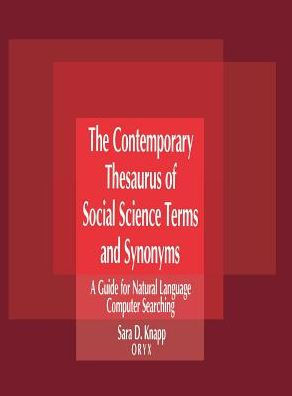Perhaps motivated by advice from F. W. Lancaster that "the most significant cause of recall failure in a natural language system is the inability of the searcher to think of all possible approaches to retrieval," Knapp has compiled this thesaurus of more than 6,000 concepts in the social sciences, together with equivalent, narrower, and related terms. Knapp, coordinator of the computer-search service at the State University of New York at Albany, is the author of a number of books and articles on online searching
The body of the thesaurus consists of entries for each concept, listed alphabetically by a keyword or phrase (e.g., "adolescence", "adolescent behavior"). Lists for each concept of related terms and synonyms range in length from a few lines to more than a column (e.g., "phobias"). Pages are well laid out, with three columns, readable type, and scope headings at the top left and top right of each two-page spread. Entries are displayed in hanging-indent format, with the heading itself set off in boldface type. Cross-references from alternative terms abound, including references from inverted forms so that access is provided via most keywords in multiword headings. Homographs are distinguished with qualifiers, for example, "depression (economic)", "depression (psychology)"
Entries do not use the standard format mandated for information-retrieval thesauruses by the recently revised National Information Standards Institute standard for thesauruses (nearing final approval and publication). Instead, they resemble the format of an alphabetically arranged dictionary-type thesaurus. This is appropriate, since the intended audience includes end-user searchers who are usually comfortable with this arrangement
The typical entry begins with the headword and equivalent terms, with alternative endings indicated for possible truncation. For instance, homosexuality begins "Homosexua (ity,ism). Lesbia (ism). Homoeroti (ism). Homoerotism. Homogenitality. Ga (ness). Tribade." Next come suggested term combinations, for example, ""Choose from": same sex "with": orientatio (s), preference, relationship." "Consider also" prefaces a list of suggested related terms, and references to related entries are indicated by "see also". Within each section of the entry, terms are arranged in conceptual order, with closely related terms next to each other, rather than alphabetically. Some entries consist of long lists of narrower terms. For example, "phobias" includes a long list of particular phobias, and "North American native cultural groups" includes a list of Native American tribes
Prefatory material includes two essays, "Basics of Computer Searching" and "Natural Language Searching," which will be very helpful for novice searchers who want a brief overview of how electronic search systems work and how to use them effectively. Appendixes are also useful: a list of "system features used in natural language searching in popular online and CD-ROM systems"; a guide to British spellings; and methods for "defining large subsets" in order to focus searches in databases that use category descriptors. The volume concludes with a lengthy list of dictionaries, thesauruses, and indexes that were used as sources for terms
It is ironic that this thesaurus for online searching must be published in a print format, rather than an electronic one. A user should be able to search this thesaurus electronically and add the terms it suggests directly to a search, without rekeying
The book quotes Lancaster as saying that "The searcher in a natural language system needs a thesaurus, or similar aid, just as much as the searcher in the controlled vocabulary system--perhaps even more so." This thesaurus admirably fills that bill for searchers of social science databases. It is designed specifically for searchers, not for indexers, and it should be very helpful for its intended audience of both librarians and end users. Academic and large public libraries that provide or encourage electronic information retrieval will want this helpful aid.



